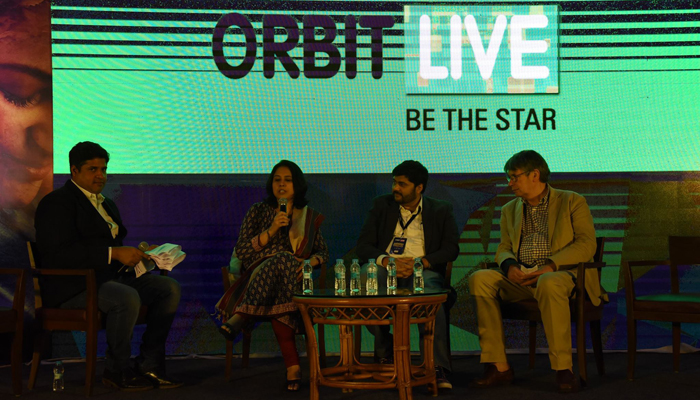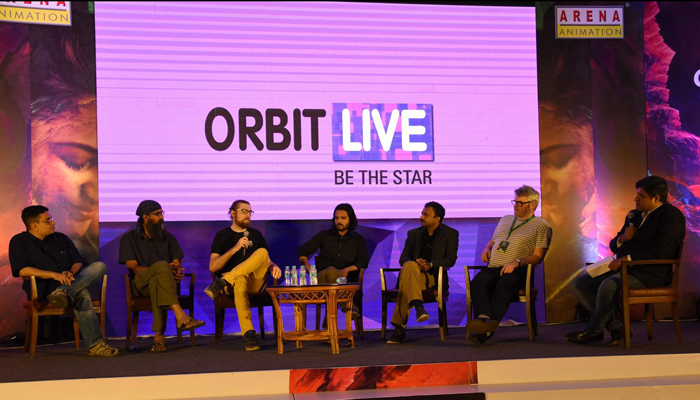On the third day of Orbit Live (4 February, 2017), an Industry Conclave was organised on the future of media and entertainment, and experts from various media houses were invited for panel discussions on a number of topics. It was inaugurated by Aptech, director, Anuj Kakar, who gave a brief on Aptech and thanked all the industry professionals for being present for the event. Highlighting Aptech’s role in helping students to interact with professionals on the working and future prospects of the industry, Kakar said, “We help the students realise their interests.” Gurnani Media founder, Anand Gurnani, hosted the panels and encouraged interaction between the audience and panellists throughout the event.
The first panel discussion was on ‘Virtual, Augmented and Mixed Reality: New Frontiers in Entertainment’, and the speakers were Happy Finish, founder, Ashish Limaye; Meraki VR, co-founder, Sairam Sagiraju; DimensionNXG, co-founder, Pankaj Raut; Enso Immersive, co-founder, Vedant Saxena.
After giving a brief about their company and work, the speakers explained to the audience what virtual reality (VR) is and how it is used in media. When asked what their mindset is when they sit with brands to discuss advertisements, Happy Finish founder, Limaye answered, “We constantly ask them if there is a real story or message that they wish to give through the ad.” Raut said that they started DimensionNXG because of a deep passion and interest in VR and AR (Augmented Reality). He explained certain problems with the technology which could be solved so the next generation of VR and AR would evolve on a higher speed. He also mentioned how the experience can be made more immersive: “with mobile-based virtual reality, you’re just sitting in a single place, but with vision-technology you can walk around with a VR based mobile handset.” What stops people from buying a head-gear is the lack of good content in VR. People will be lured to VR only if excellent content is generated. Enso Immersive co-founder, Saxena said, “Social VR allows multiple people to sit in one hall, host a chat room and interact with friends.”
The second panel was on ‘Artificial Intelligence and Deep Learning in Media Entertainment’. The panellists were Blippar India, MD, Arnav Ghosh; Super Fan, co-founder, Bineet Desai; Culture Machine, co-founder and CEO, Sameer Pitawala; Nvidia, Industry business head, Ninan EC; Vidooly, co-founder and CEO, Subrat Kar.
Artificial Intelligence (AI) is the theory and development of computer systems that are able to perform tasks normally requiring human intelligence, such as visual perception, speech recognition, decision-making, and translation between languages; and Deep Learning is a branch of Machine Learning concerned with algorithms inspired by the structure and function of the brain.
“To train the machine to perform tasks of humans; human interaction and massive computing power is needed,” Blippar India, MD, Ghosh said. “Content needs to be curated by humans; machines just replicate.” Super Fan, co-founder, Desai explained that their company uses AI around context, “to understand each and every individual at a mass scale and the type of content they want to consume, when they want to consume, and the length of content they can consume.” Understanding this helps them deliver the right content at the right time. Ghosh put it simply: “We believe words are not enough. A philosophy that we follow is if you want to know something that is not in front of you, you will go to Google and search for it. But what if there is something in front of you and you want to know more about it? If you can’t describe it, you cannot go to Google. The solution? Just point the camera at it and it comes to life.” He assured that the phone camera would work and there was no need of any extra mobile app apart from Blippar. “You need the camera to be at least 2.5 megapixels,” and their company would be the brain behind it.
Post the lunch hour, three more panels were lined up. The first was ‘VC (Venture Capitalist) Perspective on Technology Intersecting Media Entertainment’ for which the speakers were Zone Startups India, director, Ajay Ramasubramaniam; Innoven capital, associate director, Punit Shah; thinQbate, co-founder, Arjun Madhavan; Mridali; Mohit Dhawan from Times Group and Springboard Ventures.
When asked how to pitch to a venture capitalist, Innoven Capital, associate director, Punit Shah replied, “It is important to know the background of the team and staff members. They have to be focussed.” Mohit Dhawan from Times Group and Springboard Ventures commented, “We look for teams that can consistently deliver high-quality content.” He said that investing in media is more like double-taking punt. “M&E sector is much more demanding than FMCG.” Zone Startups India, director, Ramasubramaniam said that due to globalisation on an immense scale, there was a need to exchange a lot of liquidity. “Indian ecosystem is different than that of western. Hence we need to look at timing and maturity.”

‘Defining New Age Consumers and Consumption Patterns in Media and Entertainment’ was the next seminar, presided by the speakers YouTube Kids, content partnerships and outreach, Akshata Udaiver; Shemaroo Entertainment , director , Jay Maroo; NFTS, UK, director, Nik Powell.
Gurnani asked them about the traits and consumption patterns of new-age consumers. Udaiver – who handles content partnerships and outreach for YouTube Kids – answered that the age of audience has gone down drastically. Earlier, children did not have so many options as they do now. “You cannot escape entertainment. It is right in your face.” There are multiple devices in a single household. “Kids now know what they want. It is a great time for content creators but is challenging as well because the attention span of kids is very less and they have to grab that within the first ten seconds.” Shemaroo Entertainment Limited, director, Maroo continued to explain the same thing, “Kids have a very short attention span. Once you get them hooked to your content, they visit your channel again and again.”
Talking about the age group above 30, he said that they are far more willing to consume digital content. Giving an example of his family, Powell said that teenagers consume social media because they want to be a part of some group or community. Udaiver mentioned that online media has become a platform for creators. Teenagers are going beyond being just consumers. Talking about challenges, Maroo said, “Predictability and scalability is a challenge.” Powell was of the view that creating stories that people would want to watch, marketing them and making money was a big challenge. Talking about the next big trend, Udaiver said that the second most watched views on YouTube channels after English comes from South-Indian languages followed by other Indian regional languages.

The last (but not the least) panel was on ‘Emerging Trends to watch out for in Animation, VFX and Gaming’. The speakers were Firefly Creative Studio, co-founder, Sanath PC; Dhruva Interactive, studio art director, Eric Egerup; National Institute of Design, senior faculty, Shekhar Mukherjee; international award winning animation film maker, Ishan Shukla; MPC India, technology head, Shajy Thomas.
The first question was to Shukla: “What kind of trends are you seeing in the artist community?” He told the audience that we are living in a time when hardware and software are easily available which makes it possible for one person to do everything by himself. “We are not looking for money. We are only artists who have stories and who want to make films.” National Institute of Design, senior faculty of Animation Film Design, Mukherjee said that he learnt more from students than teaching them. “I encourage them to tell their stories,” he said.
Talking about the challenges and opportunities for people who follow the gaming industry, Dhruva Interactive, studio art director, Egerup said that the industry needed people who can not only produce but also think and create. “I don’t need people who know tools of today, but people who can learn tools of tomorrow.” Sharing the goals that he is building with his R&D team, MPC India, technology head, Shajay Thomas said that a few years back, animated movies were cartoon type. “Now the story is the same, characters are the same but the experience is different.” They have to do a lot of work on virtual production. Firefly Creative Studio, co-founder, Sanath PC said that a lot of efforts went into design: “The entire team’s aim is to take a story and try to expand it to a wider market.” They didn’t look at a film as a “project”. “We produce a whole universe behind the film and characters. This enables film makers to explore options other than films, like novel, game and animated films.” Mukherjee summed it up saying that at the end of the day, “everything comes down to story-telling.”
The seminar proved to be an enlightening one, opening new avenues and a completely new thinking in the field of media and entertainment.

